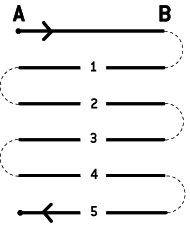GPS-assisted steering system review

To evaluate the true capabilties of GPS-guided steering systems and its advantages, Power Farming reviewed and rated the four GPS-assisted steering systems currently available in the UK. Below are the reviews and some information on accuracy and how it is measured:
 | Autofarm Ontrac system |
 | |
 | Outback Edrive system |
 | Trimble EZ-Steer system |
How to stay on track
Accuracy – where it comes from and the different ways in which you can boost it
To spray, cultivate and harvest without significant misses or overlaps, sub-metre (20cm-50cm) guidance is needed. Accuracy is not only down to the kit you put in the cab.
It comes from two things – how well the GPS receiver interprets satellite data, and the quality of any correction signal it uses.
Basic position information comes from a net of 24 GPS satellites which move relative to the earth.
Alone, this can place a tractor to within ±10m. Smart software like Outback’s e-Diff and Trimble’s OnPath can then refine that basic info for short-term, pass-to-pass fieldwork.
It is more normal to add an extra correction or differential signal. Examples, ranked by increasing cost, are the free EGNOS and StarFire 1 services, pay-for satellite services like Omnistar HP or a ground-based (RTK) set-up.
In these cases the correction source is fixed, either in the sky or on the ground, and its position is known very accurately. When a separate correction is used, plain GPS becomes differential GPS or DGPS.
Different correction sources deliver different accuracies. EGNOS (upgraded in July 2006, though still not 100% available) offers sub-metre pass-pass positioning when teamed with a capable receiver; likewise the free StarFire 1 (SF1) correction signal from Deere and the pay-for OmniStar VBS service.
Higher precision still comes from Deere’s SF2 and Omnistar’s HP services, while RTK is as good as it gets.
The trick is to pick the guidance system and correction service which best match your needs and wallet. Check that the hardware you fancy can handle the correction needed to deliver the accuracy you need.
How we measured accuracy
The diagram below shows how the tractor drove in the field. Then, each brand’s graphic (in the individual reports) shows accuracy at 5kph (blue) and 12kph (orange). For each speed, the vertical stack of boxes shows five sequential passes, driven one after the other.
The centreline of every box shows the average distance from the previous pass. The width of the box shows where the majority (68%) of logged points fell, so indicates steering wander. The wider the box, the more the tractor wandered around the average.
If the tractor weaved significantly while settling on its new course, that initial wander is buried inside the average. Where that happened it’s mentioned in the individual report.
Spotting a stability problem is easiest with an implement that leaves a visible mark in the field. Working on grass with just a tractor, small off-line errors were hard to spot. Consequently, some set-ups may be able to perform better than their results suggest.
All brands produced sub-metre accuracy as advertised. John Deere’s Universal AutoTrac delivered excellent performance. Trimble’s EZ-Steer apparently worked well on its presets, though later analysis suggested adjustment could have reduced average wander.
The Outback eDrive was very slow to find the line at 5kph, better at 12kph. AutoFarm’s OnTrac required sensitivity adjustment at both speeds to track calmly; further adjustment at 12kph could have paid off.
Can you compare?
Atmospheric conditions and GPS satellite positions change through any day. As a result it’s not possible to compare directly the accuracies of different set-ups: that can only be done if all are used in the same place at the same time.
On the other hand it’s fine to look at the pass-to-pass accuracy of an individual system, as long as the passes are made within a few minutes of each other. That’s what we’ve done here.


